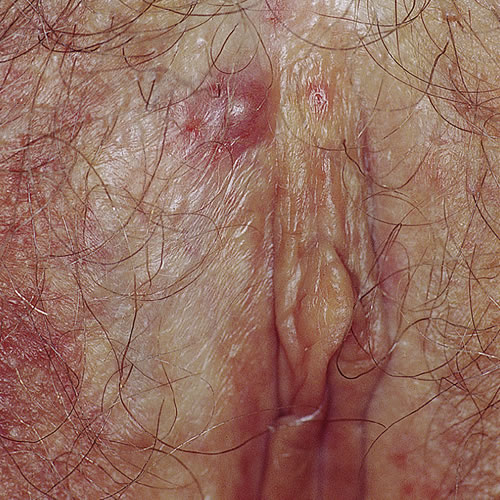Introduction
Hidradenoma papilliferum1 is an uncommon benign tumor.
Epidemiology
Incidence unknown. Occurs in women over the age of 40.
Etiology
Derived from mammary-like glands in the anogenital area,2 it was previously thought to be an apocrine gland tumor. It most commonly develops on the inner aspect of the labium major in white women, although one study described the lesion as appearing most commonly in the lateral aspects of the labia majora.3
Symptoms and clinical features
Patient history is of a sole, asymptomatic vulvar papule. The tumor presents as a sharply circumscribed, skin-colored, dome-shaped, 1 cm nodule on the interlabial sulcus or elsewhere on the labia majora.

The lesion is freely moveable. It may be umbilicated and tend to bleed.
Diagnosis
Diagnosis is made by biopsy although cytology has been used to aid in diagnosis when carcinoma was suspected.
Pathology/Laboratory Findings
Histologic sections of skin may show a well-circumscribed cystic lesion within the deep dermis. There is no connection with the epidermis. The lesion contains numerous papillary projections within blood-filled cystic spaces.
Differential diagnosis
Differential diagnosis includes nevus, cyst, and neuroma, pyogenic granuloma, some of the inflammatory nodules, especially ulcerative amelanotic melanoma (rare), adenocarcinoma, squamous cell carcinoma, and basal cell carcinoma.
Treatment/management
No treatment is necessary if the tumor is asymptomatic and the diagnosis sure. Excision is required if the tumor is symptomatic.
References
- Fisher BK, Margesson, LJ. Genital Skin Disorders: Diagnosis and Treatment. Mosby, Inc., 1998. 204.
- Scurry J, van der Putte SC, Pyman J, et al. Mammary-like gland adenoma of the vulva: a review of 46 cases. Pathology, 2009; 41:372-378.
- Uke, M,Kulkarni MB, Ajit D, Gujral S. Acta Cytologica. Sept-Oct, 2010. Vol 54,No 5. 909.